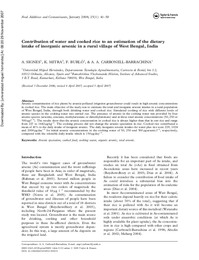Title:
Contribution of water and cooked rice to an estimation of the dietary intake of inorganic arsenic in a rural village of West Bengal, India |
Authors:
Signes-Pastor, Antonio Jose 
Mitra, K.
Burló, Francisco 
Carbonell-Barrachina, Ángel A. |
Department:
Departamentos de la UMH::Salud Pública, Historia de la Ciencia y Ginecología
Departamentos de la UMH::Tecnología Agroalimentaria |
Issue Date:
2007-08-31 |
URI:
https://hdl.handle.net/11000/34406 |
Abstract:
Arsenic contamination of rice plants by arsenic-polluted irrigation groundwater could result in high arsenic concentrations in cooked rice. The main objective of the study was to estimate the total and inorganic arsenic intakes in a rural population of West Bengal, India, through both drinking water and cooked rice. Simulated cooking of rice with different levels of arsenic species in the cooking water was carried out. The presence of arsenic in the cooking water was provided by four arsenic species (arsenite, arsenate, methylarsonate or dimethylarsinate) and at three total arsenic concentrations (50, 250 or 500 mg l 1). The results show that the arsenic concentration in cooked rice is always higher than that in raw rice and range from 227 to 1642 mg kg 1. The cooking process did not change the arsenic speciation in rice. Cooked rice contributed a mean of 41% to the daily intake of inorganic arsenic. The daily inorganic arsenic intakes for water plus rice were 229, 1024 and 2000 mg day 1 for initial arsenic concentrations in the cooking water of 50, 250 and 500 mg arsenic l 1, respectively, compared with the tolerable daily intake which is 150 mg day 1.
|
Keywords/Subjects:
Arsenic speciation
cooked food
cooking water
organic arsenic
total arsenic |
Type of document:
info:eu-repo/semantics/article |
Access rights:
info:eu-repo/semantics/openAccess |
DOI:
10.1080/02652030701385233 |
Published in:
Food Additives & Contaminants, 25:1, 41 - 50 |
Appears in Collections:
Artículos Salud Pública, Historia de la Ciencia y Ginecología
|

.png)
